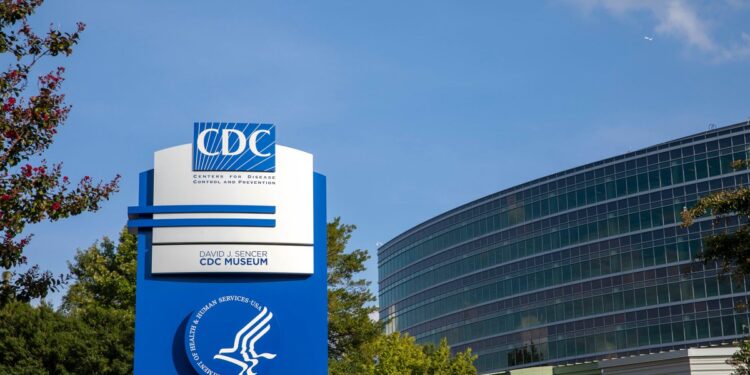Late last week, the mood at the US Centers for Disease Control and Prevention in Atlanta was tense. President Donald Trump’s new Department of Government Efficiency had called for a massive reduction in the federal workforce, after having savaged the US Agency for International Development just a few weeks before. But at the CDC, a mammoth agency with about 13,000 employees and an annual budget of nearly $9.7 billion, no one seemed to know exactly what was coming. Senior leaders weren’t sure how to prepare their teams for the immediate future, even as they all knew that at least 1,300 layoffs were imminent.
Over the weekend, Mother Jones spoke to five CDC staffers from several parts of the agency at various levels of seniority. These government workers, who requested anonymity for fear of retaliation, described a professional environment that has felt increasingly chaotic since Trump’s inauguration, with leaders scrambling to interpret and comply with broad executive orders that forbade any mention of diversity, equity, and inclusion. “We can’t do the science and the public health work anymore because we’re so consumed with responding to the executive orders or other mandates and censorship,” said one senior leader. “The current buzzwords right now are efficiency and accountability,” she added, “I cannot imagine a less efficient way of operating.” Another noted, “The feeling in the building is fear.”
One senior leader said that her team of supervisors had been given less than 24 hours to submit a list of names of workers in her center to the Department of Health and Human Services that could potentially be laid off. Those names were required to be sorted into categories organized by how critical their work was—but with only 10 percent of their workers were permitted to be categorized as being essential. The supervisors complied because “we were concerned that if we didn’t designate a top 10 percent we would just lose everybody,” she said. After spending hours engaged in the difficult task of sorting the team they learned the following day that none of their suggestions had been accepted. Those who received layoff notices seemed to be chosen at random. “The list made zero difference,” one of the supervisors said. “And we don’t think it even went up to HHS at all.”
“We can’t do the science and the public health work anymore because we’re so consumed with responding to the executive orders or other mandates and censorship.”
Another staffer shared an email that had come from senior management about the layoffs, expressing sadness about the cuts while encouraging employees to “support one another” through this difficult time.
Meanwhile, the more junior employees were left wondering when, or even if, they would receive an email informing them that they were going to be laid off. “We’re all terrified about what’s happening to our colleagues,” said one. In order to share information with one another, they had taken to using group chats on the encrypted communication platform Signal.
When it came to layoffs, rumors were flying. “I’ve gotten a lot of information about this from Reddit, not from CDC leadership, which feels very telling,” said someone who had worked [can we say for years at CDC or something so as not to us so many “staffer” references.] another staffer. The CDC did not immediately respond to a request for comment from Mother Jones.
Mother Jones obtained a screenshot of a Signal chat in which one employee warned colleagues not to open any email they suspected might be a layoff, because once the email had been read, the recipient would immediately lose access to the “network and campus.” If someone did open the email, they “should respond to it and CC [a] supervisor saying they disagree and are…filing grievance with the action and would like to know the justification.”
Finally, on Friday, the first round of layoffs appeared. But the rollout was disorganized. “I literally found out about [the layoffs] from the news,” one person said. “Like I was getting news alerts on my phone, having family and friends texting me, asking if I still had a job.”
That staffer still has a job, but someone else with whom I talked from the Division of Global Health Protection, does not. At 8:30 p.m. on Saturday, she received an email that she recognized from other reports on Signal as a notice of termination; the subject line was “Read this email immediately.” She had been hired in 2023 through a streamlined process for disabled people, though she had worked as a contractor for CDC for nearly two decades before that. CDC workers hired through that program, called Schedule A, are subject to a two-year probationary period; other employees have only one year of probation. About halfway through her probationary period, she had been told that her work exceeded expectations as part of an evaluation.
When she told her boss that she had received the termination email, the supervisor “was trying to be supportive, but she doesn’t really know what’s going to happen. She said they’re rolling with the punches, but no one’s really fighting back and there’s no firm action to take right now, because we’re at the whims of [President Trump].”
Aside from the implications for their livelihoods and careers, the haphazard nature of the layoffs was concerning to those who spoke to Mother Jones. “We have really highly skilled individuals that have technical specialties that are hard to find and hard to fill,” said one. “The fact that the current administration isn’t making strategic decisions about who to let go and what contracts to end—that is frightening.”
They all expressed dismay about the disruptions the executive orders had caused to their guidance to the public. Shortly after the release of the executive order to cease all work on projects having anything to do with diversity, equity, and inclusion, forbidding even the mere mention of one of those words, the CDC paused in publishing its Morbidity and Mortality Weekly Report, its main way of transmitting scientific information to healthcare providers and others. Yet even after the MMWR was restored a week later, staffers said, there was widespread confusion about how to interpret the orders. Some of the centers combed through all their public-facing material to scrub any mention of DEI while still keeping much of the other information intact, while others took everything down out of an abundance of caution.
The sudden disruption was especially problematic for the CDC’s partner organizations—thousands of state and local health departments, contractors, and community public health nonprofits that rely on the CDC’s guidance. A screenshot of the platform that one center uses to distribute funding to its partners showed a message saying the site was unavailable due to HHS having “issued a pause” on non-emergency external communications.
Another employee from that same center said that almost all of her meetings with partner organizations had been canceled, leaving her calendar “70 percent empty.” The only external communication that was permitted in her center was answering partners’ technical questions. Someone else noted that her center was no longer allowed to distribute approved funds to partner organizations because the funding packages “had canned language in there about the about not discriminating based on race, race, ethnicity, and sexual orientation, and all that has to be stripped before they’re able to even touch anything.”
Add to the confused messages about programs and employment was the confirmation of Robert F. Kennedy, Jr. to lead the US Department of Health and Human Services. His record of anti-vaccine activism, they said, threatened to undermine a key component of their agency’s work: the prevention of infectious diseases. Several noted that they agreed with Kennedy on some points, especially his dedication to combatting the epidemic of chronic disease in the United States. Yet they noted that any investigation of what Kennedy refers to as the “root causes” of disease would be incomplete without factoring in the influence of race, socioeconomic status, and gender on the risk of chronic disease.
And what about the well-documented racial disparities in access to health-enhancing resources such as nutritious food and safe spaces to exercise? “Black and Brown people are far more likely in most parts of the country, to have less access to these environments,” one staffer said. “I fear that in the future you won’t be able to put that in writing.” That inequity, she added, “doesn’t feel like a political statement—there’s data backing this up.”
All of these CDC employees, and now one former employee, emphasized that they believed strongly in the mission of the agency and that they had chosen a career in the government because of their dedication to public health. One person had left a lucrative career in the private sector to work at the CDC; another noted that she had chosen to serve for more than a decade despite the comparatively low pay. “The message that I want to get out there,” another said, is that “public servants are not your enemy.”







